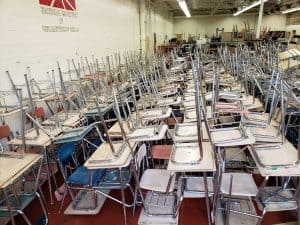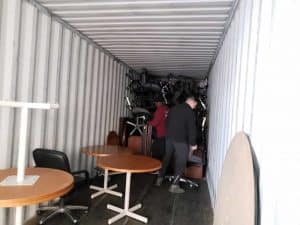by Mark Lennon

Loading residential furniture from Bridgewater State University for shipment to Jamaica / photo by IRN
What do you do with a building that’s filled with usable furniture? It’s a question that owners and contractors face almost every time they do a renovation or decommission an old building.
It’s a question we first faced in 2002 at Boston College. We handled a lot of BC’s recycling. They were doing a dorm renovation and had filled a parking lot with the old furniture. They asked us to recycle it.
We looked at it. It was good, sturdy stuff. We asked, “Why aren’t you giving this to a halfway house or homeless shelter, someone who can use it?” BC responded, “We’re in Boston. Inside 10 miles there are 35 schools and 40,000 dorm rooms. We all have this same furniture to get rid of. We’ve filled up every shelter and thrift store in three states. We just need the furniture to go away.’
So we recycled it.
But we knew there had to be a better solution, and started making calls. Not locally, but to national and international organizations that provide relief and development on a large scale. Perhaps they would be able to use good-quality furniture in whole-building quantities — hundreds, sometimes thousands, of pieces at a time.
There was supply and demand but no one to make a match
What we discovered was a market failure. There was a huge need among relief organizations for usable furniture — to rebuild after floods and earthquakes, provide families a better home, give students the chance to study at a real desk. There was more need for furniture than IRN could ever supply. But there was no one to match supply with demand.

Desks from Taconic Vocational High School, enjoying a second life at Wanje Primary School, Lilongwe, Malawi / photo by World Vision
Among the generators — organizations with furniture to dispose of — no one had time and resources to network with the dozens of charities who could possibly use the furniture. Among the potential recipients, no one had time and resources to contact the thousands of organizations that might have furniture available. Neither side had the capability to plan and manage the projects to make the transfer happen — set up moving crews, organize transportation, pack trucks, fill out customs paperwork, track the furniture to its destination.
Meanwhile good furniture in the U.S. kept going into dumpsters, and kids around the world kept sleeping on bare floors.
So we kept making calls. We started making matches with those larger charities and began moving furniture. In 2002, IRN shipped two trailers. In 2003, we shipped 20. Then 85 in 2004, 259 in 2005, and from there, the program has kept growing. Through 2018, IRN has shipped more than 6,500 trailers filled with furniture, provided by more than 600 organizations in 28 states, and supplying more than 125 nonprofit organizations in 43 states and 62 countries around the world.
Vision and implementation
Simplicity and low cost are the keys to IRN’s reuse program. Reuse may be a good thing to do, but throwing furniture away is easy, and its cost is predictable. If we can’t make reuse just as simple and cost no more than disposal, few organizations would choose reuse.
In fact, we make reuse even simpler. One tractor-trailer loaded for reuse holds as much as three or four 30-yard rolloff containers. So there’s less traffic, less congestion, fewer opportunities for delay, and a cleaner, safer jobsite.
Reuse is cost-effective because our charitable partners pay much of the expense of transporting the furnishings to the destinations they specify. There’s no difference in labor cost, because the furnishings have to come out of the building no matter what. With New England tipping fees, what IRN charges for reuse is generally 15% to 25% less expensive than throwing furniture into a landfill.
Within this cost, IRN manages the process soup-to-nuts. Before each project, we secure a detailed inventory that lets us make the best match with the right charity. We set up transportation, we provide onsite management during the project, we complete shipping paperwork, and at the back end, we provide a detailed report of exactly what the client shipped and where it has gone.
Since that first shipment in 2002, IRN’s reuse program has grown to include clients and their contractors from government, corporations, healthcare, K-12, and higher education. We do projects with small day schools and Fortune 50 companies. In 2019, we were on track to ship more than 10 million pounds of furniture — something over 700 tractor-trailers.
It’s been a fun ride since we first saw that parking lot at BC. We make a living, we have fun, we save money for our clients, and we get to do some good in the world. It’s hard to think of a better job.
Mark Lennon is co-founder and CEO of IRN — The Reuse Network.












